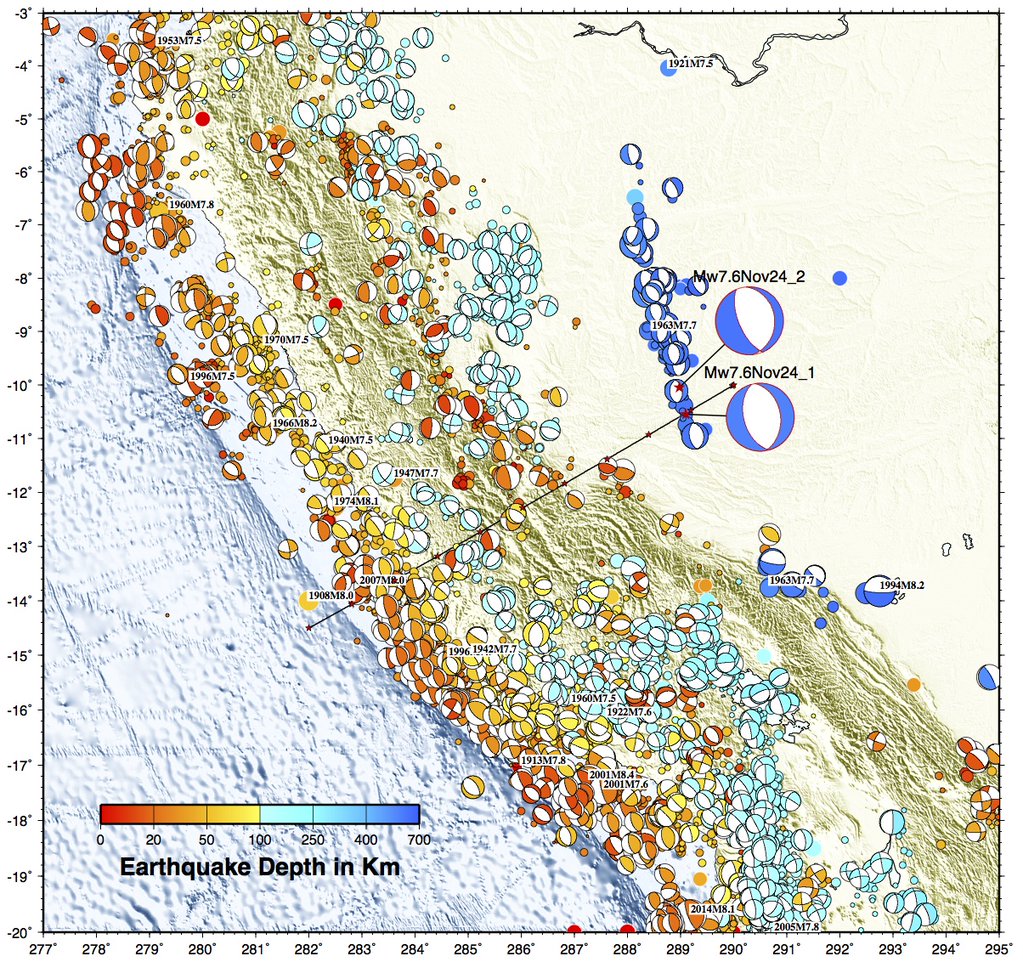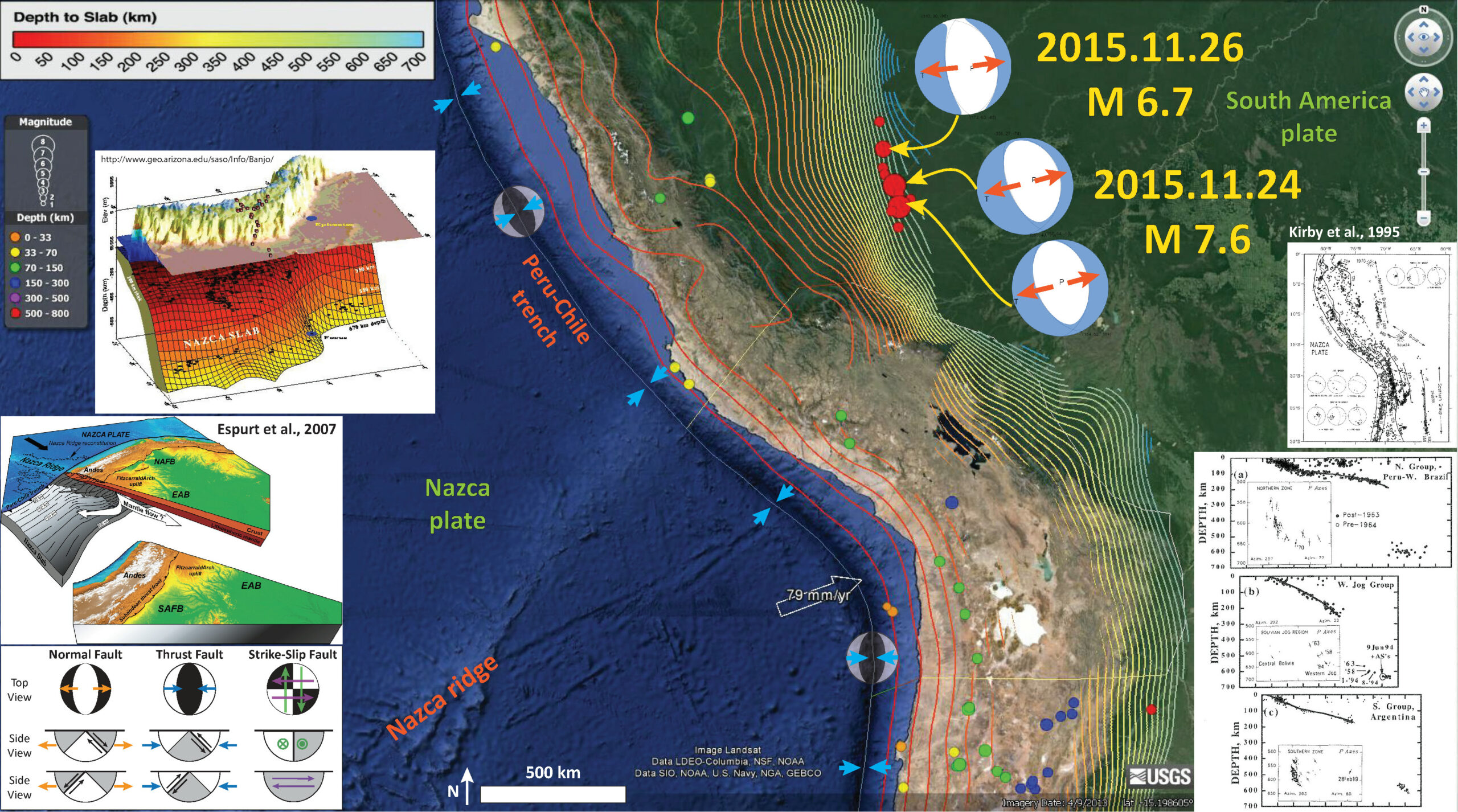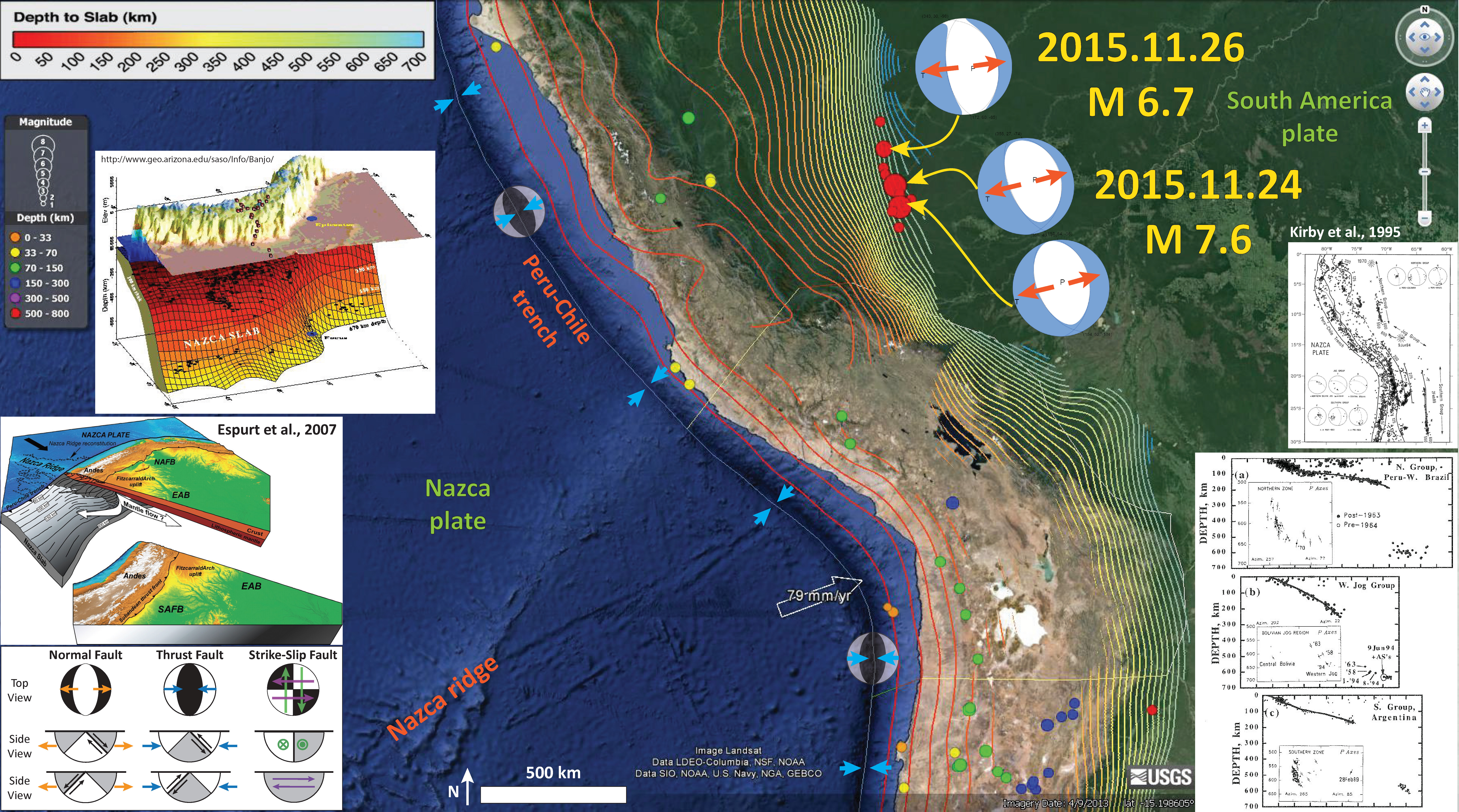There was an aftershock to the pair of M 7.6 earthquakes in Peru: an earthquake with magnitude M = 6.7 in Brazil. Here is the USGS web page for this earthquake.
I reported about the M 7.6 earthquake pair here.
Here is a map showing the M 7.6 earthquake pair and today’s M 6.7 earthquake with epicenters colored vs. depth and diameters vs. magnitude.
I include figures from Kirby et al. (1995), showing a map and three cross sections of seismicity. In their paper, they attempt to explain the deep seismicity along this subduction zone. There is a paucity of seismicity between shallower (<~200 km) and these deeper focus (~600 km) earthquakes. Silver et al. (1995) also attempt to explain this deep seismicity. Both groups of researchers evaluate metamorphic processes to explain changes in fault properties. Kirby et al. (1995) suggest these deep earthquakes align along pre-existing faults. Also, Zhan et al. (2014) evaluate the 1994 Bolivia earthquake, in comparison to the 2013 Sea of Okhotsk M 8.3 earthquake (deepest Great earthquake recorded at 637 km). They contrast these two M 8.3 earthquakes, the Sea of Okhotsk earthquake occured along a belt of metastable Olivine, yet the Bolivia earthquake did not.
I also include some oblique views of the subduction zone from (1) the BANJO project and (2) Espurt et al. (2007). The Banjo project figure shows the epicenter of the 1994 M 8.3 earthquake as a blue circle. The November 2015 earthquakes are located beneath the Fitzcarrald Arch.
I placed a moment tensor / focal mechanism legend in the lower left corner of the map. There is more material from the USGS web sites about moment tensors and focal mechanisms (the beach ball symbols). Both moment tensors and focal mechanisms are solutions to seismologic data that reveal two possible interpretations for fault orientation and sense of motion. One must use other information, like the regional tectonics, to interpret which of the two possibilities is more likely.
I also plot the earthquakes with magnitude greater than M = 7 in the below map. Note that I also add the moment tensor for the 1994 M 8.3 earthquake, one of the deepest earthquakes recorded by modern seismometers. Here is the kml file that I used to make this map. Here is the query that I used to create that kml file. I have plotted moment tensors for some of the largest earthquakes in this region. I also plot the slab contours from Hayes et al. (2012). These contours show the depth where we think that the subduction zone fault may be. These contours are largely based upon seismicity. The hypocentral depths for these deep earthquakes are deeper than the slab depth from Hayes et al. (2012).
Based on our knowledge of subduction zones and plate tectonics, the hypocentral depths, the moment tensor, and the slab contour depths, I interpret the M 7.6 earthquake to be in the downgoing Nazca plate. The plate is undergoing extension from the downgoing slab and this is the likely source of extension for the earthquakes in this region. Some subducting slabs bend, which causes bending moment normal faults. Based on plots of seismicity, it does not appear that the Nazca slab is bending in this way at this depth (typically, this bending is happening at a much shallower depth). Below is a summary map of the seismicity since 1900, showing moment tensors for the largest earthquakes. Note the 1991 M 7.0 earthquake is also extensional, but this is in a location where the slab is bending. So, this 1991 earthquake, while could be due to slab-pull extension, could also be due to extension in the upper part of the downgoing plate causing bending moment normal faults.

Jascha Polet (Geophysist at Cal Poly Pomona, twitter: at CPPGeophysics) has plotted the seismicity of this region. Below is a map that shows the location of the cross section. Dr. Polet uses Generic Mapping Tools (GMT) to plot these data.

Here is the cross section data.

Compare Polet’s plot with this figure from Kirby et al. (1995). The November swarm fits in the upper most panel.
-
References:
- Espurt, N., Baby, P., Brusset, S., Roddaz, M., Hermoza, W., Regard, V., Antoine, P.-O., Salas-Gismodi, R., and Bolaños, R., 2007. How does the Nazca Ridge subduction influence the modern Amazonian foreland basin? in Geology, v. 35, no. 6, p. 515-518.
- Hayes, G. P., D. J. Wald, and R. L. Johnson, 2012. Slab1.0: A three-dimensional model of global subduction zone geometries, J. Geophys. Res., 117, B01302, doi:10.1029/2011JB008524.
- Kirby, S.H., Okal, E.A., and Engdahl, E.R., 1995. The 9 June 94 Bolivian deep earthquake: An exceptional event in an extraordinary subduction zone in Geophysical Research Letters, v. 22, no. 16, p. 2233-2236.
- Silver., P.G., Beck, S.L., Wallace, T.C., Meade, C., Myers, S.C., James, D.E., and Kuehnel, R., 1995. Rupture Characteristics of the Deep Bolivian Earthquake of 9 June 1994 and the Mechanism of Deep-Focus Earthquakes in Science, v. 268, p. 69-73.
- Zhan, Z., Kanamori, H., Tsai, V.C., Helmberger, D.V., and Wei, S., 2014. Rupture complexity of the 1994 Bolivia and 2013 Sea of Okhotsk deep earthquakes in Earth and Planetary Science Letters, v. 385, p. 89-96.



Nice article Jay! Deep earthquakes are a thought provoking concept for sure. Earthquake localities and mineral deposit occurrences coincide nicely at times.